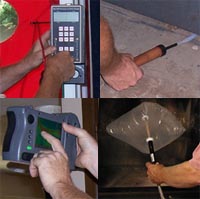Saving Home Energy
Here is a list of some free and cheap energy saving ideas that are good advice for summer or winter:
$100 or less ideas
- Roll of Aluminum tape or mastic tape to seal the seams of the heating vents in the attic or basement = $20 for a roll
- Use squares of rigid insulation foam to make a box cover for the attic pull down stairs = $35 worth of foam and glue.
- If you have a drafty window or door pull the molding off to see if there is any insulation around the window jamb gap = $7 for a can of low expansion window foam.
- Use a Chimney draft excluder like a Chimney Balloon or Flueblocker to plug the fireplace to prevent drafts through the damper = $45-$55 per fireplace
- Clean your AC coils. If you don’t want to fork out $100 or more for a professional AC tune-up, at least check your outside compressor and make sure it is clear of weeds, grass clippings and dirt free. Even a clean looking compressor can have a thin film of dirt on its fins, and that is limiting the heat transfer. Buy a can of foaming coil cleaner from the home improvement store and use your garden hose on low pressure to clean the fins. = $7 for a can of coil cleaner.
- Chase down drafts with a DIY energy audit. On a particularly windy day close your home up as tightly as you can. Then use a Smoke Pencil ($35) to check all your windows and doors and plumbing penetrations under your sinks to see if you are taking in air through the cracks. Use foam and caulk to seal them up. Then turn on your AC unit and while it is blowing, go to your attic or crawlspace (wherever your ducts are) and check the ducts with the smoke pencil to see if the joints and seams are leaky ad need more mastic applied.
- If your garage or attic tend to get super-heated, radiant barrier panels can help mitigate this. You can install these reflective panels into your ceiling joist bays in the attic or against your garage door sections to reflect out much of the radiant heat gain that is transferring into your home. They generally cost about $100 for 50 panels, which will cover most moderate sized attics.
Free
- Vacuum out HVAC return vent covers.
- Adjust the dampers on the heating vents to heat the rooms evenly.
- Do not use an open wood or gas log fireplace during cold weather. They tend to suck in more heated air from the home than they provide back.
- Clear the outside dryer vent exhaust flapper of any lint. The flapper should close back up completely when the dryer isn’t running.
- Keep long curtains from covering furnace and A/C vents (you would be surprised how often we see this)
- If you find bent/flattened fins on your AC coil, take the time to carefully use a butter knife to bring them back to straight. This also improves air flow and heat transfer.
